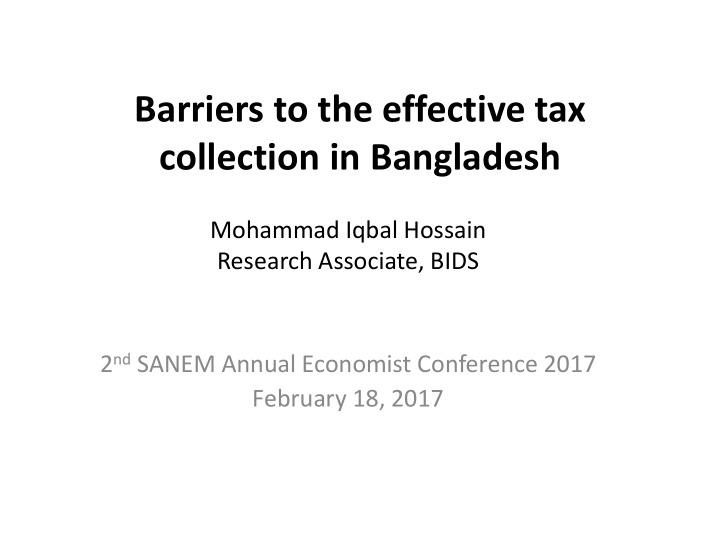



Barriers to the effective tax collection in Bangladesh Mohammad Iqbal Hossain Research Associate, BIDS 2 nd SANEM Annual Economist Conference 2017 February 18, 2017
Background • The Bangladesh economy has made remarkable progress in achieving GDP growth, reducing poverty and social development • Over time, there has been structural transformation in the economy with a shift from traditional agriculture-led economy towards industry-led economy • As economic development takes place the country’s tax system should generate more revenue automatically for the national treasury (Chowdhury & Hossain, 1988). • Over time, the average Tax-to-GDP ratio improved gradually and increasing to 9.04 percent during the 2010-2016 period from 8.17 percent in 2000- 2010 period. However, the Tax-to-GDP ratio of Bangladesh still remains one of the lowest in the world and even lower compared to that of Nepal (16.5 percent in 2014-15, Ministry of Finance, Napal). • Due to lack of domestic revenue mobilization the budget deficit increased 3.9 percent of GDP to 5.0 percent of GDP in 2016
Objectives of the Study • Bangladesh government has set to enhance revenue mobilization target to 14.1 percent of GDP in the final year of seventh five-year plan, 2020, which seems unrealistic with the current progress and past experiences during 2000-2016. • To attain revenue target it is necessary to identify; why Bangladesh have trapped in low tax-gdp ratio and the main long – run determinants of tax revenue, both its major items as well as its aggregate total? • The general perceptions for low Tax-GDP ratio – First: narrow tax base – Second, revenue looses due to trade liberalization – Third, low potentially of tax administration and growing practice of tax evasion and corruption. • The objective of the study is to identify the determinants of low tax revenue in Bangladesh. More specifically, to examine whether the potentiality of the economy is low or the collection issues matters?
Tax Revenue Structure of Bangladesh: Stylized Facts • Low tax-GDP ratio • Dominance of indirect taxes and less diverse • Tax revenue dependency shift from import/trade tax to domestic level taxes • Customs dependency gradually and slowly replaced by income tax, although there are much more scope for improvement are untouched
Tax Capacity and Tax Efforts: Evaluation of Tax Performance • The tax-GDP ratio provides an approximation measure of tax effort of a country, but it could give “completely distorted” estimates of effectiveness of revenue generation, especially, across countries with different economic structure (Tuan, Blanca and Bayraktar, 2012). • The tax capacity could one of the solutions to measure the tax effort of a country. • The study has been estimated tax effort indices considering the basic tax bases to check whether the potentiality of the country’s economy is low or collection issues matters. • This empirical analysis used tax base data of 51 countries and used pooled OLS, random effect and fixed effect model has been applied. Using the regression coefficients of the tax capacity have been calculated for each country and then dividing the actual tax income to get tax effort. • A higher tax effort will be indicated if the resulting ratio greater than 1 and vice versa. This is a simplified method to measure tax efforts for cross- country, it gives some likelihood measures for the policy makers to take initiatives for improving tax system or structure.
Tax Capacity and Tax Efforts: Evaluation of Tax Performance (where Bangladesh locates?) Country Tax Effort Country Tax Effort Country Tax Effort Trinidad and 1.79 Bulgaria 1.14 Indonesia 0.84 Tobago Kyrgyz Dominica 1.62 Kenya 1.08 0.83 Republic Morocco 1.60 Belarus 1.07 Honduras 0.82 Botswana 1.57 Mali 1.07 Philippines 0.80 Namibia 1.54 Egypt, Arab Rep. 0.99 Uganda 0.78 Croatia 1.34 Togo 0.97 Malaysia 0.76 Georgia 1.34 El Salvador 0.93 Guatemala 0.74 Belize 1.33 Jordan 0.92 China 0.71 Bosnia and 1.30 Ghana 0.90 Pakistan 0.71 Herzegovina Benin 1.27 Nepal 0.89 India 0.71 Grenada 1.27 Latvia 0.88 Madagascar 0.65 Brazil 1.25 Burkina Faso 0.88 Ethiopia 0.61 Angola 1.25 Thailand 0.87 Cambodia 0.60 Armenia 1.22 Cote d'Ivoire 0.87 Maldives 0.59 Tunisia 1.21 Zambia 0.86 Bangladesh 0.54 Cabo Verde 1.18 Sri Lanka 0.86 Bhutan 0.50 Mongolia 1.14 Nicaragua 0.84 Afghanistan 0.49
Determinants of Taxation in Bangladesh: Time Series Estimation • To identify the determinants of the low tax revenue in Bangladesh the study has been used double log regression model using time series data starting from 1973 to 2014.The following model is used to identify the determinants of tax-gdp ratio:
Estimation Results and Discussions • Income Tax: increasing tax evasion by individual and taking advantages of weak monitoring and evaluation capacity of the tax administration the limited capacity, in the absence of income database tax administration cannot track the potential tax evasions and legal action also takes long time to resolve • Efficiency of revenue mobilization • Multiple tax rates • Size of the informal economy • VAT • Multiple tax exemption/tax holidays
Summary and Conclusions • The actual tax-GDP ratio was found to be very low compared with the selected developing countries. • Even after taking into consideration the normative or taxable capacity, the tax efforts remained very low compared to those countries and also other south Asian countries. • narrow base both in terms of income and population is the primary cause of poor tax yield from direct taxes in Bangladesh • Base should be widening and more equitable among sectors, by revising exemption limits and eliminating various concessions. • Tax system are nor organized well enough to generate tax revenue as the economy grow, and it requires more and more discretionary policy measure to boost up the tax revenue. • Rural and semi-urban area in the country are not covered properly under VAT net, which could generate more revenues. • Various exemptions, different tax rates creates complications make it difficult for efficient tax administration providing sufficient scope for tax avoidance. • Tax rates on corporate profits can be uniform which might enhance the investment and also tax administration efficiency.
Thank You
Recommend
More recommend